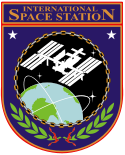STS-100
 | |
| Dane misji | |
| Indeks COSPAR | 2001-016A |
|---|---|
| Zaangażowani | |
| Oznaczenie kodowe | STS-100 |
| Pojazd | |
| Wahadłowiec | Endeavour |
| Załoga | |
 Od lewej: Jurij Łonczakow, Scott Parazynski, Kent Rominger, Umberto Guidoni, Jeffrey Ashby, Chris Hadfield i John Phillips | |
| Dowódca | Kent V. Rominger |
| Start | |
| Miejsce startu | Stany Zjednoczone, KSC, LC39-A |
| Początek misji | 19 kwietnia 2001 18:40:42 UTC |
| Orbita okołoziemska | |
| Apogeum | 394 km |
| Perygeum | 377 km |
| Okres orbitalny | 92,3 min |
| Inklinacja orbity | 51,6° |
| Lądowanie | |
| Miejsce lądowania | Edwards Air Force Base, pas startowy 22[1] |
| Lądowanie | 1 maja 2001 16:10:43 UTC[1] |
| Czas trwania misji | 11 dni, 21 godzin, 30 minut i 1 sekunda[1] |
| Przebyta odległość | 7 902 181[1] |
| Liczba okrążeń Ziemi | 186[1] |
| Program lotów wahadłowców | |
STS-100 – misja amerykańskiego wahadłowca Endeavour do Międzynarodowej Stacji Kosmicznej. Załoga statku kosmicznego z powodzeniem wykonała główne zadanie, tj. dostarczyła, zainstalowała i przetestowała urządzenie Canadarm2.
Był to szesnasty lot promu kosmicznego Endeavour i sto czwarty programu lotów wahadłowców[2].
Załoga
- Kent V. Rominger (5)* – dowódca misji
- Jeffrey S. Ashby (2) – pilot
- Chris Hadfield (2) – specjalista misji 1 (Kanada)
- Scott Parazynski (4) – specjalista misji 3
- John L. Phillips (1) – specjalista misji 2
- Umberto Guidoni (2) – specjalista misji 4 (Włochy)
- Jurij Walentinowicz Łonczakow (1) – specjalista misji 5 (Rosja)
- *(liczba w nawiasie oznacza liczbę lotów odbytych przez każdego z astronautów)
Parametry misji
- Masa:
- startowa orbitera: 103 506 kg
- lądującego orbitera: 99 742 kg
- ładunku: 4899 kg
- Perygeum: 377 km[4]
- Apogeum: 394 km[4]
- Inklinacja: 51,6°[4]
- Okres orbitalny: 92,3 min[4]
Dokowanie do ISS
- Połączenie z ISS: 21 kwietnia 2001, 13:59:00 UTC
- Odłączenie od ISS: 29 kwietnia 2001, 17:34:00 UTC
- Łączny czas dokowania: 8 dni 3 godzin 35 minut
Spacery kosmiczne
- Ch. Hadfield i S. Parazynski – EVA 1
- Początek EVA 1: 22 kwietnia 2001 – 11:45 UTC
- Koniec EVA 1: 22 kwietnia – 18:55 UTC
- Łączny czas trwania: 7 godzin 10 minut
- Koniec EVA 1: 22 kwietnia – 18:55 UTC
- Ch. Hadfield i S. Parazynski – EVA 2
- Początek EVA 2: 24 kwietnia 2001 – 12:34 UTC
- Koniec EVA 2: 24 kwietnia – 20:14 UTC
- Łączny czas trwania: 7 godzin 40 minut
- Koniec EVA 2: 24 kwietnia – 20:14 UTC
Cel misji
Dziewiąty lot wahadłowca na stację kosmiczną ISS – dostarczenie pierwszej części manipulatora SSRMS. Dostawa zapasów na stację w module MPLM Raffaello[2].
Zobacz też
Przypisy
- ↑ a b c d e Adam Chen, William Wallack, George Gonzales: Celebrating 30 Years of the Space Shuttle program. NASA, 2012. ISBN 978-0-16-090202-4.
- ↑ a b c Tomáš Přibyl: Dzień, w którym nie wróciła COLUMBIA. Debit, Czerwiec 2003. ISBN 83-7167-224-1.
- ↑ Robert Godwin: Space Shuttle. Warszawa: Prószyński Media Sp. z o.o., 2011, s. 84, seria: Historia podboju Kosmosu. ISBN 978-83-7648-973-5.
- ↑ a b c d STS 100 (ang.). W: NSSDCA Master Catalog [on-line]. NASA. [dostęp 2014-06-20]. [zarchiwizowane z tego adresu (2016-03-08)].
Linki zewnętrzne
- podsumowanie misji STS-100 na stronie KSC (ang.)
- Mark Wade: STS-100 (ang.). W: Encyclopedia Astronautica [on-line]. [dostęp 2017-07-27].
- Spaceflight mission report: STS-100 (ang.). Spacefacts. [dostęp 2017-07-27].
Media użyte na tej stronie
The flag of Navassa Island is simply the United States flag. It does not have a "local" flag or "unofficial" flag; it is an uninhabited island. The version with a profile view was based on Flags of the World and as a fictional design has no status warranting a place on any Wiki. It was made up by a random person with no connection to the island, it has never flown on the island, and it has never received any sort of recognition or validation by any authority. The person quoted on that page has no authority to bestow a flag, "unofficial" or otherwise, on the island.
These international astronauts and cosmonaut have been in training in a number of venues for the April 2001 visit to the International Space Station (ISS). Seated are astronauts Kent V. Rominger (left) and Jeffrey S. Ashby, commander and pilot, respectively, for the STS-100 mission. Standing, from the left, are cosmonaut Yuri V. Lonchakov, with astronauts Scott F. Parazynski, Umberto Guidoni, Chris A. Hadfield and John L. Phillips, all mission specialists. Guidoni represents the European Space Agency (ESA); Hadfield is with the Canadian Space Agency (CSA) and Lonchakov is affiliated with Rosaviakosmos.
Logo of Nasa's STS-100 mission.
- The STS-100/6A emblem reflects the complex interaction of robotics and extravehicular activity (EVA) on this mission. During the mission spacewalks will be conducted to deploy the International Space Station Remote Manipulator System (SSRMS). The EVA helmet frames the patch, with the Canadian-built SSRMS shown below the visor. Reflected in the visor is the Space Shuttle Endeavour, with the International Space Station rising above the horizon at orbital sunrise. Endeavour's payload bay houses a Spacelab pallet, itself holding the SSRMS and the Space Station Ultra High Frequency Antenna, and the Italian-built Multi-Purpose Logistics Module "Raffaello." American, Russian, Canadian, and Italian astronauts compose the crew, and their flags are stylized in the lower portion of the emblem. Ten stars adorn the sky, representing the children of the STS-100 crew and the future of space exploration.




